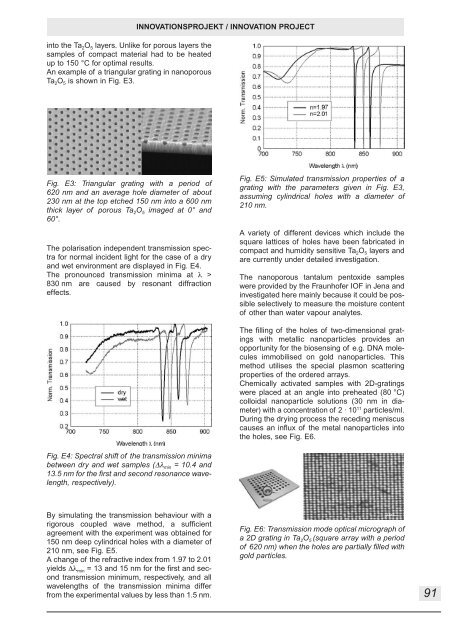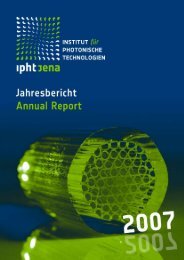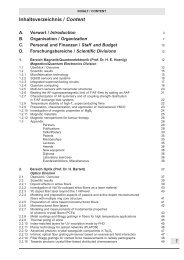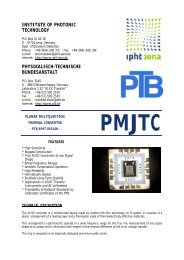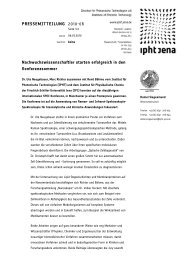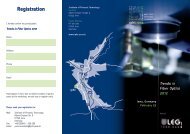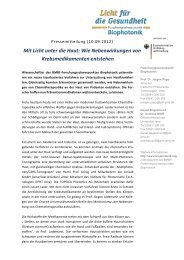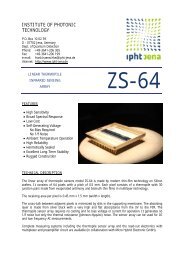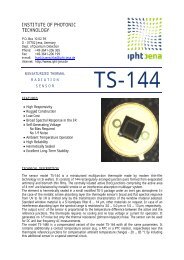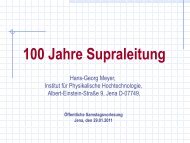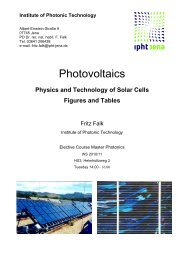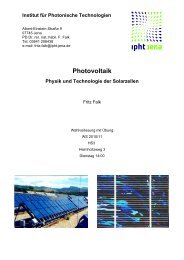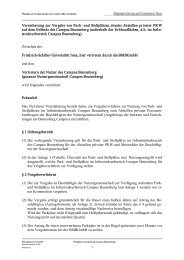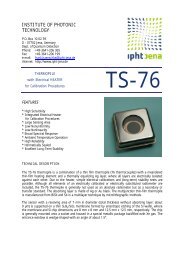Jahresbericht 2005 - IPHT Jena
Jahresbericht 2005 - IPHT Jena
Jahresbericht 2005 - IPHT Jena
You also want an ePaper? Increase the reach of your titles
YUMPU automatically turns print PDFs into web optimized ePapers that Google loves.
into the Ta 2O 5 layers. Unlike for porous layers the<br />
samples of compact material had to be heated<br />
up to 150 °C for optimal results.<br />
An example of a triangular grating in nanoporous<br />
Ta 2O 5 is shown in Fig. E3.<br />
Fig. E3: Triangular grating with a period of<br />
620 nm and an average hole diameter of about<br />
230 nm at the top etched 150 nm into a 600 nm<br />
thick layer of porous Ta 2O 5 imaged at 0° and<br />
60°.<br />
The polarisation independent transmission spectra<br />
for normal incident light for the case of a dry<br />
and wet environment are displayed in Fig. E4.<br />
The pronounced transmission minima at λ ><br />
830 nm are caused by resonant diffraction<br />
effects.<br />
Fig. E4: Spectral shift of the transmission minima<br />
between dry and wet samples (∆λ min = 10.4 and<br />
13.5 nm for the first and second resonance wavelength,<br />
respectively).<br />
By simulating the transmission behaviour with a<br />
rigorous coupled wave method, a sufficient<br />
agreement with the experiment was obtained for<br />
150 nm deep cylindrical holes with a diameter of<br />
210 nm, see Fig. E5.<br />
A change of the refractive index from 1.97 to 2.01<br />
yields ∆λ min = 13 and 15 nm for the first and second<br />
transmission minimum, respectively, and all<br />
wavelengths of the transmission minima differ<br />
from the experimental values by less than 1.5 nm.<br />
INNOVATIONSPROJEKT / INNOVATION PROJECT<br />
Fig. E5: Simulated transmission properties of a<br />
grating with the parameters given in Fig. E3,<br />
assuming cylindrical holes with a diameter of<br />
210 nm.<br />
A variety of different devices which include the<br />
square lattices of holes have been fabricated in<br />
compact and humidity sensitive Ta 2O 5 layers and<br />
are currently under detailed investigation.<br />
The nanoporous tantalum pentoxide samples<br />
were provided by the Fraunhofer IOF in <strong>Jena</strong> and<br />
investigated here mainly because it could be possible<br />
selectively to measure the moisture content<br />
of other than water vapour analytes.<br />
The filling of the holes of two-dimensional gratings<br />
with metallic nanoparticles provides an<br />
opportunity for the biosensing of e.g. DNA molecules<br />
immobilised on gold nanoparticles. This<br />
method utilises the special plasmon scattering<br />
properties of the ordered arrays.<br />
Chemically activated samples with 2D-gratings<br />
were placed at an angle into preheated (80 °C)<br />
colloidal nanoparticle solutions (30 nm in diameter)<br />
with a concentration of 2 · 10 11 particles/ml.<br />
During the drying process the receding meniscus<br />
causes an influx of the metal nanoparticles into<br />
the holes, see Fig. E6.<br />
Fig. E6: Transmission mode optical micrograph of<br />
a 2D grating in Ta 2O 5 (square array with a period<br />
of 620 nm) when the holes are partially filled with<br />
gold particles.<br />
91


